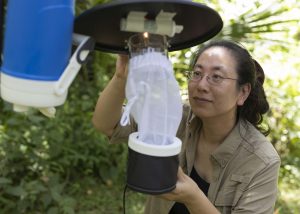
Mosquitoes’ sense of smell tells them when humans and wildlife are in biting distance, according to science. Over time, scientists have learned which types of scents and fragrances can lure mosquitoes best.
Over the next two years, a team of researchers from the University of Florida Institute of Food and Agricultural Sciences (UF/IFAS) will develop a low-cost mosquito trap to lure mosquitoes and create a web-based dashboard to improve surveillance across the southeast United States.
Yoosook Lee and Lindsay Campbell, assistant professors of entomology and nematology at the UF/IFAS Florida Medical Entomology Laboratory, are the recipients and co-principal investigators on a $296,143 grant from the U.S. Department of Agriculture’s (USDA) National Institute of Food and Agriculture (NIFA). Lee, who specializes in molecular ecology, and Campbell, who focuses on spatial ecology, will collaborate with Brian Byrd of Western Carolina University.
The trap, retrofitted from the classic light trap used by the Centers for Disease Control and Prevention (CDC), will be baited with mosquito-luring scents and will include heat, along with timed intervals for light exposure.
“The goal is to attract more mosquito species to the trap to improve invasive mosquito surveillance. Some of the scents include commonly used carbon dioxide to attract a broad range of mosquito species and a human lure that mimics body odor,” said Campbell.
A second objective is to enhance a prototype digital dashboard system already developed to visualize incidents of non-native and invasive species. The enhanced dashboard will improve invasive mosquito surveillance by promoting data sharing and communication among states in the southeastern region of the United States, where the species have been detected.
“We expect that our approach will capture a greater diversity of mosquito species using a one-trap system, which will improve its likely adoption by mosquito control and public health professionals,” said Lee. “Our project is aligned with the USDA National Integrated Pest Management Roadmap in reducing potential human health and safety risks from pests by improving pest-management strategies.”

In 2021, UF/IFAS researchers founded a multidisciplinary and multi-state working group with mosquito control districts in the southeastern United States known as the Mosquito Biodiversity Enhancement and Control of Non-native Species (BEACONS). The group tries to improve the scope for non-native and invasive mosquito surveillance and control in the southern United States. Lee serves as a program director of the working group.
BEACONS members conducted a needs-assessment survey in seven southern states: Alabama, Florida, Georgia, Louisiana, Mississippi, North Carolina and South Carolina. Three of 90 mosquito control agencies and related public health agencies participated in this survey and identified key obstacles impeding invasive mosquito surveillance. Through this survey and in-person workshops, they identified priority invasive mosquito species in the southeastern United States.
Campbell, a Mosquito BEACONS co-program director, has been working in Florida since 2018 to share more information about mosquito trap collections for analyses over time and space and to develop prevention and mosquito control strategies. She has provided Geographic Information Systems training to mosquito control professionals in nine states and territories along the coast from Louisiana to North Carolina and Puerto Rico.
Campbell has generated multiple species distribution models of invasive mosquito species at regional and global scales, including, most recently, Aedes scapularis, which is new to Florida. She will enhance an existing digital dashboard to improve surveillance among the BEACONS working group states. Each state will be able to map the occurrences of non-native and invasive species.
Every year, Florida faces challenges from mosquito-transmitted diseases like dengue virus, West Nile virus, eastern equine encephalitis virus, chikungunya virus and others. Florida’s proximity to the tropics and climate conditions makes it ideal for non-native mosquito species to find themselves in the Sunshine State, and scientists are concerned about the rate and frequency of new species establishing in Florida.
As many as 17 non-native mosquito species are established in the state. Researchers stress that the detections of non-native mosquito species are increasingly frequent, with 11 of 17 non-native species first reported in the past two decades, and six of these 17 detected in only the past five years, according to a recent study.
“Combining efficient trap collections with digital technologies, such as dashboard mapping and analysis tools, will improve communication among the states and help to target surveillance and control activities while providing a framework for an effective integrated pest management approach,” said Campbell.
###
Lourdes Mederos, rodriguezl@ufl.edu
ABOUT UF/IFAS
The mission of the University of Florida Institute of Food and Agricultural Sciences (UF/IFAS) is to develop knowledge relevant to agricultural, human and natural resources and to make that knowledge available to sustain and enhance the quality of human life. With more than a dozen research facilities, 67 county Extension offices, and award-winning students and faculty in the UF College of Agricultural and Life Sciences, UF/IFAS brings science-based solutions to the state’s agricultural and natural resources industries, and all Florida residents.
Source: UF/IFAS Pest Alert
Note: All images and contents are the property of UF/IFAS.



